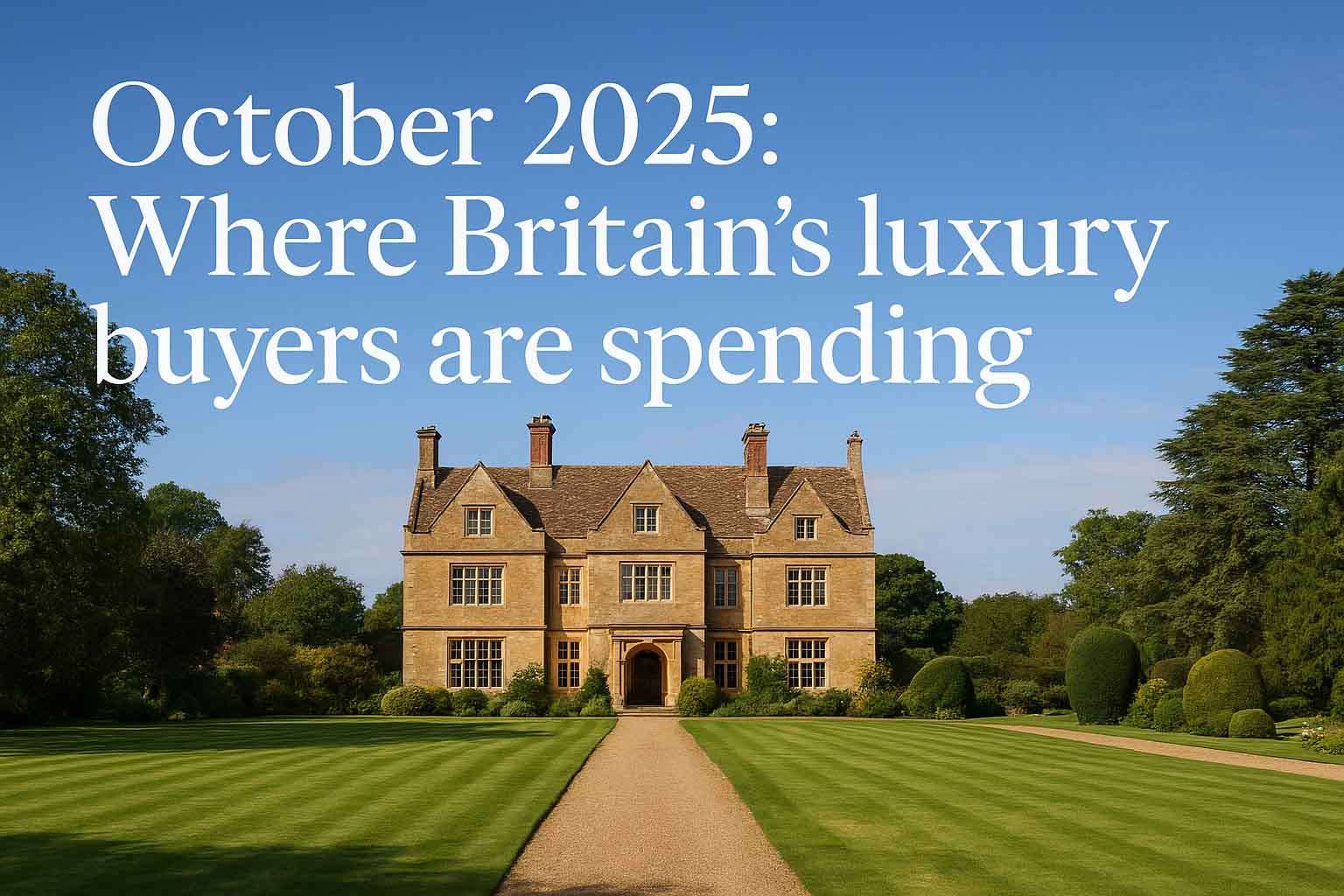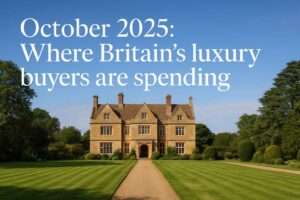Luxury Property Market Update October 2025
Where Britain’s luxury buyers are spending: a regional market update
Executive summary (short)
Autumn 2025 finds the UK luxury property market in a state of cautious re-balancing rather than collapse. At the national level, mainstream housing shows surprising resilience with modest price growth in recent months, but prime segments are more uneven. Prime London — and especially the super-prime (£10m+) tier — has shown pockets of renewed strength as international and discretionary buyers re-engage, while many high-end country-house markets that boomed during the pandemic are undergoing a correction: asking-price reductions have become common and negotiation power has shifted towards well-prepared buyers. Lending costs, Budget uncertainty and the post-non-dom tax landscape are the principal near-term influences shaping wealthy buyers’ behaviour. Key evidence for these views comes from leading market reports published in October 2025 by major broker research teams and national commentators. (Savills PDF)
Introduction — the shape of luxury in October 2025
The pandemic years rewired aspirations: a surge in demand for space, countryside living and second homes pumped prime-region values to new highs. Two years on, those dynamics have normalised unevenly. Where buyers still prize convenience to city centres and a high-quality lifestyle, prices have stabilised or even risen slightly; where expectations were fuelled by temporary remote-work premiums, the market is now adjusting back toward longer-term fundamentals.
This October, the picture is best described as selective and regionally divided. Mainstream measures show modest growth across the UK as a whole, reflecting stronger performance in many northern regions and stable activity in several commuter belts, but the story diverges markedly when you split London super-prime, Greater London/Home Counties, city-region prime and rural country-house markets. This article unpicks those differences region by region and offers practical insight for high-net-worth buyers, sellers and advisers. (Savills PDF)
National overview: stability with divergence
Headline figures out in October 2025 show the UK housing market — including the upper tiers — holding up better than many commentators forecast earlier in the year. Nationwide and other broad indices recorded modest month-on-month growth in late summer and early autumn, and activity has shown some stabilisation after a prolonged period of caution. That resilience masks important splits: the North vs South performance gap persists; urban prime areas with strong employment and amenity draws have outperformed much of the rural prime stock; and super-prime trophy assets continue to attract global capital. (Savills PDF)
The macro backdrop matters. Interest-rate direction and mortgage availability still constrain many domestic buyers, while tax changes and the end of some non-dom tax arrangements in 2025 have nudged behaviour among ultra-wealthy individuals. Policy uncertainty ahead of the autumn Budget has encouraged a degree of “wait and see” activity — some buyers accelerate deals to secure positions before potential tax changes, while others pause. In this mixed environment, well-priced, well-marketed homes are selling; homes priced at the former pandemic peaks, particularly in rural hotspots, are taking longer and often require reductions. (coutts.com)
London — prime and super-prime
Snapshot: Selective recovery in prime London; rising super-prime activity; lettings demand strengthening.
By mid-2025 we began to see a clearer positive tilt in prime London pricing and sentiment. Analytical work from dedicated prime-market indices shows that prices in central prime pockets rose through the first half of 2025 and that rental values have been firming — an important dynamic for investors and occupiers alike. The return of international buyers into certain segments of the market, combined with a shortage of the very best stock, has helped underpin prices for the most desirable homes. (coutts.com)
What’s driving demand in London now?
- Global wealth flows and repositioning. Ultra-high-net-worth buyers continue to use London both as a residence and as a strategic asset: trophy apartments and townhouses in the most desirable postcodes remain a recognised safe harbour. Knight Frank’s super-prime intelligence confirms that sales in the $10m+ bracket are meaningful and frequently cross-border in origin. (Knight Frank)
- Rental market tightness. Lettings performance in prime central and outer London improved through September 2025 with rents rising in several prime zones; this increases gross yields for buy-to-let at the top end and supports investor interest. Policies that increase the attractiveness of selling (for example regulatory change affecting landlords) can reduce supply and paradoxically support rental values. (Knight Frank UK)
- Stock scarcity at the top. For genuinely exceptional properties — penthouses, palatial mews houses and townhouses on quiet garden squares — supply remains tight, sustaining premiums for quality and location.
Market dynamics for sellers and agents
- Pricing precision is critical. For prime flats and houses in the best postcodes, small pricing errors now have a big impact on sale speed and the discount demanded by buyers. While some sellers can secure near-peak prices, many are finding that realistic, data-driven pricing combined with premium marketing wins deals. (coutts.com)
- Off-market and discreet sales remain valuable. High-net-worth clients still prefer quiet processes to public listings, and agents offering access to international buyer networks and family office channels are seeing success.
- Short-term tactical plays. Some buyers are accelerating purchases ahead of the Budget or to lock in financing arrangements; others wait for tax clarity. This results in short bursts of activity rather than a steady flow.
Practical advice (London)
Buyers: prioritise readiness — finance lined up, solicitors instructed, and the ability to move quickly on clean, well-presented transactions. Sellers: invest in appetising marketing (virtual staging, lifestyle content) and be prepared to act swiftly on credible offers.
Greater London & the Home Counties
Snapshot: Continued demand for properties combining London access with privacy and space; negotiating room for buyers in many sub-markets.
The Home Counties remain a bedrock for luxury purchasers seeking a balance between city access and country comforts. Places such as Surrey, Berkshire and parts of Hertfordshire and Kent continue to see interest where commutability is under an hour and where properties offer modern home-working space, gardens and strong schools. However, the market is more negotiation driven: buyers are more discerning and many vendors must prove reasoned flexibility on price and timing. (Savills)
Regional nuances
- Commuter belts within 45–60 minutes: areas with fast rail links to central London (for example some parts of Surrey and Berkshire) have stayed relatively resilient. Properties that combine modern infrastructure, low maintenance and professional landscaping perform well.
- Secondary commuter locations: where journeys are longer or public transport less frequent, price sensitivity is higher and time-to-sale lengthens.
What sellers should do
- Use precise comparables and be transparent about premium features (recent renovations, EPC ratings, AV systems) — high-end buyers pay for certainty.
- Consider professional styling and timing: autumn viewings still produce good quality attendees but realistic expectations about discounting are necessary.
South West & the Cotswolds (including Cornwall and Somerset)
Snapshot: The pandemic premium on spacious country houses has eased; many rural prime postcodes are seeing an uptick in price reductions and longer chains.
The country-house market has been the most discussed story of 2025: after a powerful pandemic-era surge in demand, pockets of the rural luxury market are now realigning to pre-Covid fundamentals. National newspapers and specialist commentators report that a large share of rural listings have had reductions, and agents cite a longer time-to-sale in areas that had previously been extremely active. Buyers are in a stronger negotiating position in many localities, especially in amenity-rich but more isolated spots. (The Times)
Regional commentary
- Cornwall and coastal retreats: once extraordinary growth areas, many Cornish properties have been subject to meaningful downward adjustments from their pandemic peaks. That said, truly exceptional coastal homes and houses with distinctive provenance continue to attract attention from both UK-based second-home buyers and overseas purchasers who prize privacy and sea views. (The Times)
- The Cotswolds and Somerset: pockets with a deep history of demand remain liquid, but the market is now rewarding realistic pricing rather than aspirational listing values. Buyers who value access to high-end local amenities (golf, equestrian facilities, good schools) still pay for those features.
Opportunity windows
For buyers with patience and solid financing, autumn 2025 presents opportunities to buy desirable country houses at a discount to 2021–22 asking levels. Sensible advice is to examine shortlists carefully, budget for the full ownership costs of running a large estate, and use a trusted local agent to navigate known chains and legacy issues.
The Midlands (Derbyshire, Worcestershire, Warwickshire)
Snapshot: Stable demand for accessible country homes and small estates; buyers attracted to balance of space and reasonable proximity to regional cities.
The Midlands occupies an interesting middle ground: it offers large homes and estate-style properties without the extreme price tags of the South, and is accessible to strong regional employment hubs. Areas edging the Cotswolds and pocketed villages with excellent schools or estate management services have seen steady interest from buyers seeking both lifestyle and relative value. Off-market listings are becoming more common as local HNW networks search for discreet opportunities. (Mishcon de Reya LLP)
Market signals
- Well-positioned properties that offer turn-key living (recent refurbishments, energy retrofits, good broadband) command interest.
- Agricultural or heritage complications (e.g. listed farm buildings or tied tenancies) still deter a non-specialist buyer and can lengthen chains.
Advice (Midlands)
For sellers: focus on presentation and clear documentation — buyers expect less friction for high-value country purchases. For buyers: demand independent valuations and a thorough maintenance and running-cost estimate before committing.
North of England — Manchester, Leeds, Lake District & Cheshire
Snapshot: Urban-edge prime markets outperform many rural pockets; professional buyers and local HNW buyers underpin liquidity.
In northern city regions, quality homes close to major employment and cultural centres are demonstrating greater resilience relative to rural country houses. Manchester and Cheshire, in particular, have seen sustained demand from executives and entrepreneurs who require easy access to city employment but also desire larger homes and good school catchments. The Lake District, as a lifestyle destination, retains strong interest for unique properties and estates, but not all rural postcodes are immune to the correction seen elsewhere. (Savills)
Investor interest
Institutional and professional investors have shown appetite for prime residential in northern cities, attracted by relative value and improving rental dynamics. This institutional engagement supports liquidity in the £1m+ bracket in city suburbs and established neighbourhoods.
Local peculiarities
- Cheshire’s suburban villages continue to attract families trading London prices for more space and arguably better value.
- In and around Leeds and Harrogate, lifestyle-led buyers are again active though they remain price-sensitive.
Scotland — Edinburgh, Glasgow, Highlands & Islands
Snapshot: A mixed market: city prime steady; Highlands and islands buoyed by lifestyle demand but listings increased.
Scotland offers a diverse prime market. Edinburgh and selected parts of Glasgow maintain steady interest in high-quality homes close to cultural and educational centres. Meanwhile, the Highlands and islands continue to draw buyers chasing privacy, sporting estates and coastal living. At the same time, there is evidence of broader listing growth — more Scottish country houses are on the market now than in 2021–22 — which gives buyers more choice and more negotiation leverage for non-exceptional stock. (The Super Prime)
Trophy assets
Castles, large sporting estates and islands trade sporadically but still command premium pricing where provenance, privacy and scale converge. Those assets attract both domestic HNW buyers and international purchasers seeking unique holdings.
Wales & Northern Ireland
Snapshot: Quiet, steady demand for coastal retreats and country estates; limited super-prime movement.
Both Wales and Northern Ireland present niche but steady prime markets. Coastal areas in Wales remain attractive for second-home buyers and lifestyle seekers; listings here are competitive for genuinely well-located homes. Northern Ireland’s prime market is smaller in scale; high-value estates change hands infrequently and transactions are typically bespoke and discreet. (Garrington Property)
Practical note
Buyers should account for limited stock and the potential for longer marketing periods on specialist properties; local solicitor and tax advice is essential, especially for cross-border or international purchasers.
The national country-house correction: what changed and why
One of the clearest autumn 2025 trends is the reversion of many rural prime markets to more conservative pricing. Country houses that appreciated dramatically in 2020–22 are in many cases trading with price reductions compared with earlier aspirational asking levels. Multiple industry commentators and regional reporting show that a significant share of rural listings have been reduced in price and that transaction times have lengthened. This is not a uniform story: the very best sites with exceptional settings and provenance still command strong buyer interest, but a much larger tranche of the market has softened. (The Times)
Key reasons for the correction
- Post-pandemic normalisation of working patterns. Remote work accelerated demand for rural homes; as hybrid working settles into a more balanced pattern, the urgency for large country homes has eased for many.
- Tax and regulatory changes. Proposed and enacted policy changes in 2025 — including end of certain non-dom tax rules and broader tax debates — have affected the calculus for second-home ownership and for holding multiple residences. This has a pronounced effect in markets that had been driven by second-home buyers. (The Guardian)
- Affordability and mortgage pricing. Higher borrowing costs for many buyers, plus lenders’ increased caution on large, unusual properties, have reduced the pool of ready purchasers for some estates.
- Stock replenishment. After a period of low listings, more vendors have relisted their homes, increasing choice and amplifying buyer negotiating power.
Buyer opportunity
For motivated buyers who understand the full cost and complexity of running a large home, the correction brings opportunities to secure desirable homes at more realistic values. Due diligence — from structural surveys to running-cost projections and checks on boundaries and rights of way — is especially important.
Macro drivers and the policy context
Three macro themes dominate near-term thinking among luxury buyers and advisers:
- Interest rates and mortgage availability. While some lenders have eased pricing in 2025, mortgage structuring for very high-value properties remains bespoke. The direction of base rates and wholesale funding costs still governs the cost of leverage for many buyers; those who buy with cash tend to enjoy better negotiation positions. Broad market reports in October 2025 show that mortgage-sensitive buyers are behaving cautiously, but market sentiment brightens when rate cuts are priced into markets. (Savills PDF)
- Budget and tax changes. The autumn Budget and ongoing tax reform conversations matter hugely for high-value transactions. Changes to stamp duty, capital gains treatment or other owner taxes will influence timing decisions for some buyers and sellers. Advisers increasingly recommend factoring the fiscal calendar into strategic planning for high-value purchases. (coutts.com)
- International mobility and tax residency shifts. The abolishment of certain non-dom rules in 2025 has been a talking point for the luxury market. There is evidence that some wealthy individuals have reconsidered UK residential plans, and certain luxury services (cars, watches, property) have responded to shifting demand. This creates both short-term volatility and longer-term recalibration in lifestyle asset ownership patterns. (The Guardian)
What buyers should be doing in October 2025
- Be ready to move quickly on compelling stock. Where pricing and condition are right, sellers are rewarding certainty. Have your finance organised, surveyors on call and solicitors primed.
- Think long term about running costs and adaptability. Large houses bring ongoing maintenance and energy considerations. Look for recent retrofits (insulation, heat pumps, windows) and realistic EPCs.
- Use local expertise. The best local agents know the hidden chains, access rights and typical pitfalls of their patch. For super-prime deals, relationship networks matter: family office contacts, private banks and specialist brokers often open doors.
- Negotiate professionally. In many rural and some suburban prime markets, the buyer has the upper hand — credible, well-structured offers often secure properties at a discount to headline asking prices. (The Times)
What sellers should be doing in October 2025
- Price with discipline. Data-led pricing and an objective view of recent comparable sales attract serious buyers; aspirational listings that ignore reality will languish.
- Invest in presentational excellence. For luxury homes, professional photography, virtual tours, tasteful staging and high quality marketing collateral still make a measurable difference to sale speed and price.
- Be pragmatic on timing and process. Consider off-market launches to targeted buyer lists and be open to slightly extended completion windows if that secures a better headline price.
- Prepare full documentation. Clear title, up-to-date surveys, full service histories and transparent running costs reduce transaction friction and increase buyer confidence.
The outlook into 2026 — three plausible scenarios
- Gentle stabilisation (most likely): Continued modest growth in mainstream indices, selective strength at the top of London and a gradual normalisation of rural values toward pre-pandemic fundamentals. This scenario assumes central banks edge rates lower, encouraging buyers to re-enter cautiously. (Savills PDF)
- Policy-led pause: An unexpected suite of fiscal measures in the Budget (stamp duty changes, new levies on second homes or more aggressive capital taxation) triggers a short-term drop in second-home demand and some market re-pricing. Behavior becomes more transactional and seasonal while market participants reassess strategy. (coutts.com)
- Return of strong global flows: If global liquidity and wealth growth accelerate and sterling weakens, super-prime London and trophy UK assets could benefit from renewed international buying — pushing liquidity upward at the very top even as broader rural markets remain subdued. Knight Frank’s super-prime research shows how global flows can decouple top-end performance from the domestic norm. (Knight Frank)
How advisers and agents are adapting
Professional advisers — from private banks to boutique estate agents — are refining their propositions to match the new market reality:
- More bespoke financing solutions for high-net-worth buyers, including bridging and portfolio lending.
- Family office and international buyer outreach to widen the potential purchaser pool for distinctive assets.
- Deeper pre-sale preparation (surveys, legal packs, planning history) to shorten chains and reduce the buyer’s perceived risk.
- Integrated marketing combining high production-value media, lifestyle storytelling, and access to curated buyer lists.
These tactics are proving effective where buyers value certainty and presentation as much as price.
Case studies (anonymised and illustrative)
1. A Mayfair penthouse (central London)
A newly refurbished penthouse in a recognised prime square sat on the market for six weeks. The vendor instructed a specialist prime broker, produced a high-quality video tour and engaged international contacts. Two competitive bids arrived within a fortnight of launch and the property exchanged at a price within 2% of the vendor’s revised target. The lesson: for genuine trophy stock, scarcity and presentation still command premium outcomes.
2. A Cotswolds country house
A substantial country house listed in spring 2024 at an aspirational value failed to attract offers and was re-priced in 2025. The vendor undertook energy upgrades and improved access, relaunched off-market and accepted a patient but realistic offer — notably lower than the original headline figure but within market expectations for condition and location. The lesson: buyers are discerning and pricing must reflect today’s market, not 2021 peaks.
3. A Cheshire suburban estate
A family relocating from London found value in a well-appointed Cheshire village house. Local demand from executives relocating from the city produced several offers and a sale close to asking. The lesson: city-adjacent markets with good schools and transport links retain durable demand.
Data sources and methodology notes
This update draws on consolidated market intelligence compiled in October 2025 from leading research houses, regional specialists and national market commentators. Core inputs include monthly and quarterly prime-market indices, regional research notes, and investigative reporting on rural market movements. Those sources consistently show a combination of modest national resilience, renewed strength in some prime urban pockets, and material softening in many rural prime postcodes. (Savills PDF)
(If you would like the raw tables referenced here — for example, prime-city price indices, % listings reduced in selected rural postcodes, and recent super-prime transaction lists — I can prepare an appendix of headline figures and a one-page data sheet suitable for use in your own market briefing.)
Practical checklist — buying and selling in October 2025
For buyers
- Have evidence of funds and a pre-instructed solicitor.
- Commission a thorough pre-offer survey for country houses.
- Build a short list of three must-have features and two negotiables.
- Consider off-market channels for discreet purchases.
For sellers
- Test the market with a targeted soft launch.
- Prepare a complete information pack (surveys, service records, planning history).
- Invest in professional visuals and lifestyle copy.
- Be prepared to negotiate and to allow an inspection window for committed buyers.
Final words — a market of nuance, not uniformity
October 2025’s luxury property market is characterised by nuance. The blanket narratives of either “boom” or “bust” don’t hold up to the regional detail: London’s very top end and well-located suburban properties are seeing pockets of strength; many rural prime markets are undergoing necessary price realignments; and policy developments — both fiscal and regulatory — remain a prominent influence on buyer psychology.
For anyone transacting at the top end of the UK market, the rules are timeless even if the mood shifts: understand the market you are targeting, price and present intelligently, and work with advisers who have depth in the specific geography and in the mechanics of high-value transactions. The autumn offers opportunity — for buyers who move decisively and for sellers who choose realism over optimism.
(Article compiled using independent market analysis and the latest prime-market research published in October 2025 by leading industry commentators and major brokerage research teams.) (Savills PDF)







